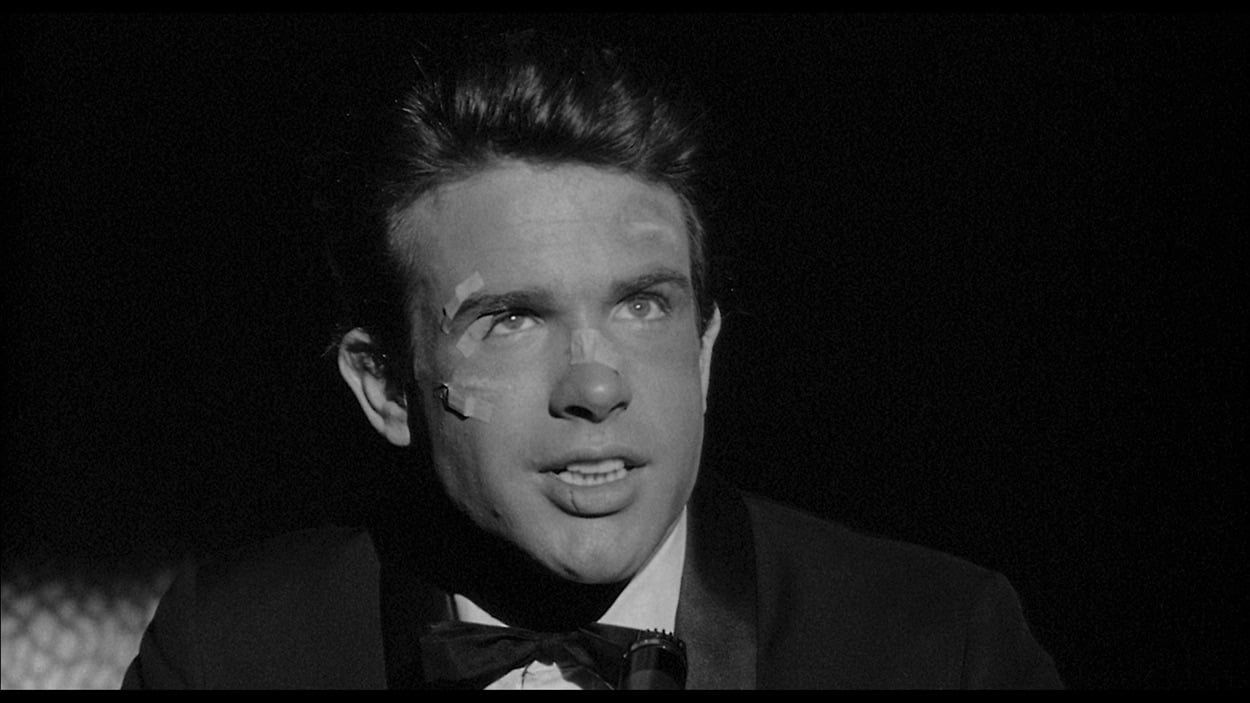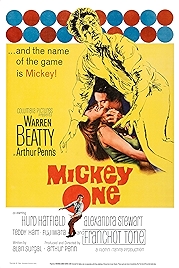Old Hollywood meets new in Mickey One, a neglected thriller from 1965 directed by Arthur Penn and starring Warren Beatty, both of whom would upend the cosy certainties of a sclerotic industry with Bonnie and Clyde two years later. They run through a few of the possibilities here.
The film focuses almost entirely on Beatty, as a club comedian and light-entertainment guy who goes on the run from the Mob after getting on the wrong side of them over money, a woman, and possibly a few other things. Mickey One is what the fugitive ends up being called after assuming the identity of a turned-over vagrant, “One” being as near as most people can get to the vagrant’s Polish surname. And after trying life as a hobo, then as a skivvy in a restaurant, Mickey decides to take a risk with a gig in a rundown club far enough from the Mob’s orbit to be safe. He hopes.
Mickey (not yet called that) is introduced in a stylish visual running under the opening credits – a fully dressed Mickey in coat and hat in a steam room with some sweaty Mob guys laughing fit to bust in their towels. It’s a stylish film with a strand of surrealism that marks it out, and deliberately punctures attempts at thriller-style tension.
The 1950s and 1960s are in constant dialogue. The thriller side of things is 1950s, so are the monochrome looks and wiseguy supporting characters. The surrealism is 1960s, as if the zaniness of The Monkees TV show (which would air the following year) was being given a try-out. The saxophone of Stan Getz – another of the bridges from 1950s to 1960s – parps away improvisationally on the soundtrack, 50s jazzy rather than 60s lounge-y.
Clearly made for little money, with post-dubbed sound allowing director Penn to shoot with light rigs in a freeform style, Mickey One’s monochrome looks also tell a story of a film no one really expected much from. Penn was a TV guy, in the days when that mattered. The writer was a comedy guy and also from TV. In fact Alan Surgal never wrote another film screenplay. And Beatty, though a star since 1961’s Splendor in the Grass, wasn’t yet the sort of name who could open a film.
The collision of old and new is most obvious in the backstage scenes. As the film opens the conversation that Mickey has with Mob go-between Ruby Lapp is given extra heft because Lapp is played by Franchot Tone, a Hollywood name and star of the 1930s and 1940s, who is a minor character here. Weary-looking, Tone would be dead within three years.
Later, when Mickey embarks on his suicidally dumb comeback, he gets an agent, the dog-eared Berson (Teddy Hart), whose scenes with club booker Castle (Hurd Hatfield) couldn’t be more juxtapositional – Berson in wide-lapel pinstripes and tatty pork-pie hat, the hatless Castle drinking a smoothie, and extolling the virtues of organic food in his suit with narrow lapels. Later, he’s seen using an electric toothbrush. Modern.
Beatty has the charisma necessary to pull of the light-ent/comedy persona, and the writing when he’s on stage is quick and smart. But this is also a tale of paranoia taking a bite out of Mickey’s flip front. As the comedian rises again on the club circuit, he knows that the Mob will eventually work out who “Mickey” actually is.
This leads to several scenes of Mickey on stage, under a single beady spotlight, sweating because he’s convinced that this is the night the shot will ring out. Penn/Beatty and Surgal could have worked the film’s paranoid moments into something really gripping, but instead undermine them at every turn, with injections of surrealism – a comedy trampoline, a conceptual artist who seems to have borrowed his shtick from Harpo Marx, the police arriving all sped-up, Keystone Cops style – all intruding when least expected.
This fight between the paranoid and the surreal continues all the way to the end and is, in dramatic terms, the film’s ruin. But it also singles it out as a weird experiment, albeit one that would be worked through most fully on TV rather than on the big screen.
There’s a lot to enjoy. Arthur Penn has an eye (he’s the brother of genius photographer Irving Penn so maybe it’s in the DNA), Beatty has the charisma, the supporting cast – Tone, Hatfield and Hart in particular, but also Alexandra Stewart as Mickey’s complex love interest – is strong. It is in many ways a missing-link movie helping smooth the way from one era to another very different one – from trenchcoats to kaftans. No wonder it’s odd.
Mickey One – Watch it/buy it at Amazon
I am an Amazon affiliate
© Steve Morrissey 2021


